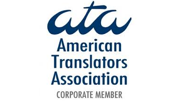September 26, 2013 by admin
Get a Free Quote
Our Accreditations





Recent Updates
Culture-bound syndromes and how language shapes illness
In her book Sleeping Beauties, neurologist Suzanne O’Sullivan explores the phenomenon of culture-bound illnesses around the world. The conditions she is interested in are psychosomatic disorders which arise due to a complex interaction between the mind and body, but… Read More
As a linguist I am sometimes asked what I think is the most difficult language to learn. Having studied German, French, Japanese and Spanish at various stages my knowledge is relatively limited, and from my point of view there is no definitive answer. But, some are definitely more difficult than others.
As an English native, Japanese was the hardest for me because I had to learn a new writing system and hundreds of characters before being able to read anything. But for a Chinese native reading written Japanese would be relatively easy as they share many of the same characters. Generally speaking the closer the language is to the speaker’s mother tongue in terms of syntax, pronunciation and culture the easier it will be to learn. The following are the top five languages that are most difficult for native English speakers to learn. The Foreign Service Institute[i] has created a ranking based on the estimated number of hours required to reach ‘general professional proficiency’- the top 5 are in Category V (2200 hours)!
Arabic
Not only do language learners have to deal with learning spoken Arabic, which can be difficult for English natives as many consonant sounds are produced at the back of the throat, there are many dialects for each Arabic speaking region to master. The alphabet for written standard Arabic is made up of 28 symbols, and letters may change shape or may be/not be connected to other letters depending on where they appear in a word. Written text is also written from right to left. Main difficulties include the 12 forms of personal pronouns, verb forms which are mostly irregular and a grammatical system which has few similarities with the English language.
Cantonese
Cantonese originates from the Canton (or Guanzhou) region of Southern China, it is widely spoken, but also has various sub dialects. This is a tonal language which English speakers find difficult as we most often use rising intonation and inflections to ask questions. Cantonese has 8 tones, using different tones affects the different meanings of each syllable. The written language (or Traditional Chinese) is evidently difficult as you need to learn many characters (approximately 3500) before you can read a newspaper, for example. Other difficulties include sentence structure (placing words in different places can change the meaning of the sentence drastically) and verbs that don’t indicate tense (adverbs which indicate time/context are used instead).
Mandarin
Mandarin Chinese has four tones and is more widely spoken and is often referred to as ‘Standard Chinese’, and like Cantonese has various dialects spoken in different regions of China. Interestingly it is also one of the UN’s official 6 languages (although Cantonese is not). Though Simplified and Traditional Chinese have similar sentence structure to English (subject-verb-object), this is a topic prominent language. Showing respect is also a difficult issue for English speakers, as Chinese speakers show varying degrees of politeness by the words they use when addressing people. Traditionally Chinese has been written from top to bottom and right to left which can cause some English speaking learners problems, though modern usage tends to be read from left to right.
Japanese
Though Japanese is also a character based language, pronunciation shouldn’t be an issue for English natives as the vowel and consonant sounds are similar to those used in English. But, on top of the characters derived from Chinese there are two other writing systems (katakana and hiragana) that you’ll need to get your head around. Grammatically speaking Japanese is fairly straight forward, but what is challenging is the use of honorific language. Japanese has varying levels of politeness, with the most polite, for example, requiring the use of different verb forms.
Korean
Unlike some of its Asian cousins Korean doesn’t use tones or a pictorial writing system, but instead uses the Hangul phonetic writing system, which is easier to master. However, spoken Korean has many sounds unfamiliar to English speakers. The biggest difficulties then lie in the grammar, with verbs conjugated in many different ways as well as adjectives depending on tense, mood or seniority. For example verbs can be conjugated in different ways to show a varying level of respect for the speaker’s or writer’s audience.
And the next in line? Finnish, Thai, Hungarian, Vietnamese….
Which is the hardest language you’ve learnt?
Get a Free Quote
© 2024 All Rights Reserved
Rosetta Translation, 133 Whitechapel High St, London E1 7QA · 0207 248 2905
Comments
Add Comment